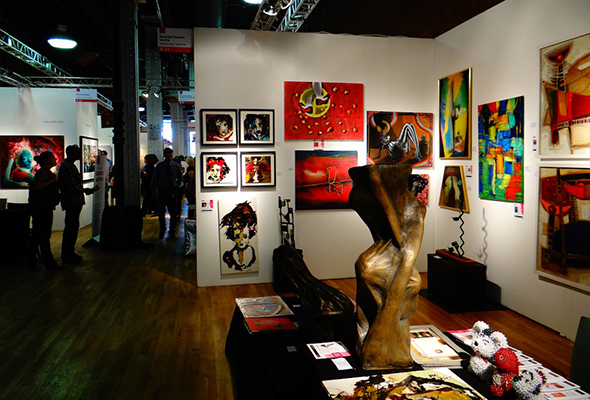
The Affordable Art Fair , newly based in Chelsea, was a whirl of colors, pop-art paintings, captivating black-and-white portrait photographs and provocative sculptures showing Polly Pocket toys having sex.
Michelle Mariaud, director of the New York-based gallery Living with Art on Lafayette Street, had two successful days at the fair, selling 25 paintings, most of them nature photography and prints, for under $2,000. “It’s my fourth year exhibiting here and the most successful so far,” she said. I’ve sold much more than I thought to both art-collectors and first-time buyers.”
The fair, held from October 4 to 7 and attracting thousands of visitors, relocated this year to the former home of the 1980’s nightclub, The Tunnel, in West Chelsea. The high ceilings and the bricks gave the venue an intimate and warm atmosphere, and the narrow long shape of the building was ideal to present galleries’ work in an organized structure.
“We moved because we wanted to be at the heart of the art industry in New York. Chelsea attracts more art-enthusiasts,” said Cristina Salmastrelli, director of the Affordable Art Fair. “The art world is not excluded from the difficult economic times, but here, people can find art no matter what their budget is.”
The Affordable Art Fair started 12 years ago in London, and came to New York 10 years ago, where it is now held every spring and fall. In addition to New York, the fair takes place in Seattle, Los Angeles, and 11 other cities worldwide. Globally, over one million people have visited one of the Affordable Art Fairs and purchased over $250 million of art.
Both regular art-collectors and first-time buyers attended the fair to see contemporary paintings, photographs and sculptures priced from $100 to $10,000, and half of the pieces were under $5,000.
There are a few requirements for galleries to be able to show their work at the fair: at least three different artists must be shown in a booth, all artists must be alive, and all work has to be original and priced under $10,000, according to Salmastrelli.
However, some artists expressed frustration with the event.
“Most people come to look and show interest, but then they keep walking. I’ve sold one piece for around $2,000 so far,” said Catrin Rothe, director and owner of the Art Project Producers’ Gallery Berlin. Her works included oil paintings of flowers in vivid colors, pop-art collages and installations of Polly Pocket toys having sex. She traveled from Berlin to exhibit her gallery’s for the first time at the fair because she wanted to experience the New York art market, but was not pleased when people tried to lower the set price. “When people try to bargain I have to draw the line. Art has to have value and I’m operating on a serious level of quality,” she said.
At the spring 2012 event in New York, more than 12,000 people visited the fair and purchased more than $4 million worth of artwork. In this fall edition, 62 small and mid-range galleries from all over the world, 15 of whom are based in New York, showed their work. Tickets at the door were $12 for adults for the day.
“In some ways, the art market is actually having an upsurge at the moment,” said Nancy A. Barton, associate professor of art and art education at New York University. “For young artists the most important thing is to make strong thoughtful work, and to … build up a reputation as a serious artist, one who is worth investing in and who is not going to disappear in a few years.”
Still, affordability is open to interpretation.“I consider pieces under $5,000 affordable for people who love art,” said visitor Lila Vas, who works in retail fashion and attended the fair for the first time. She said she was interested in a few pieces — but had to discuss it with her husband first.